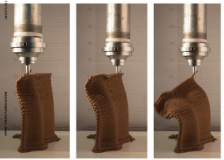It seems we can’t find what you’re looking for. Perhaps searching can help.
Syllabus
Structural design for 3D Printing

One of the primary characteristics of architecture is its need to be structurally sound. Working with materials and form, architects and structural engineers have developed methods over millennia to design, calculate, and build structures with increasing freedom and accuracy.
3D printing, with its promise of free form fabrication, challenges those methods towards new possibilities of material optimisation assisted by computer analysis. Yet, extrusion-based additive manufacturing like earth 3D printing has intrinsic constraints from the gravitational force exerted during the fabrication process, when the shape is not yet fully completed or the material is not yet solidified.
This workshop will be the occasion to understand the structural behaviors at stake during the 3d printing process and to discover how geometry influences the printability and the structural properties of the object during and after the 3D printing process. Students will have the opportunity to design their own geometries, to learn how to predict its structural behaviour using computational analysis, and to finally physically test their 3D printed design until failure.
Learning Objectives
- Understanding structural behaviours in 3d Printing
- Getting familiar with structural analysis with the Finite Element Method (FEM)
- Ability to interpret data from FEM analysis.
- Incorporating structural logic in the design of geometry
- Creating a suitable environment for the physical testing of 3D printed objects
- Ability to interpret data from Physical testing
- Extracting a set of simple logics to be used in further design (Structural toolkit)




